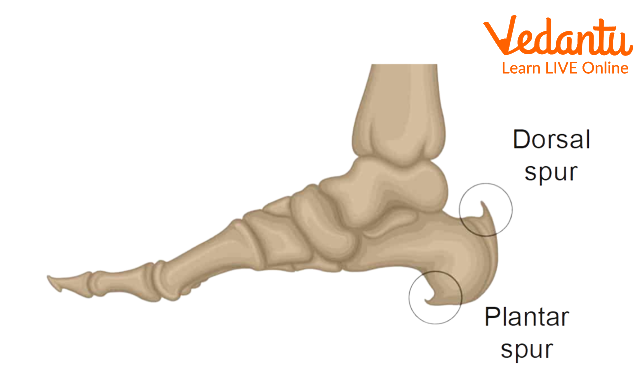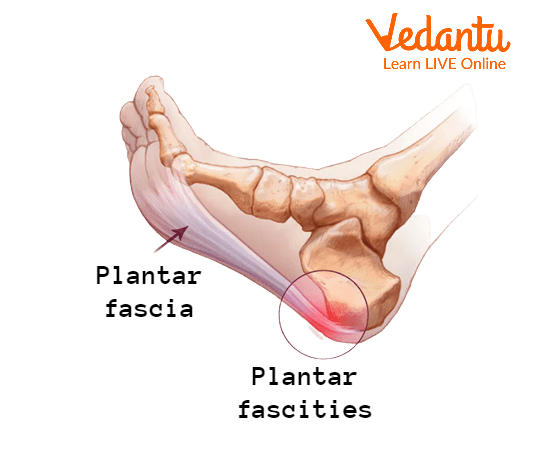How to Identify and Manage Heel Spurs and Plantar Fasciitis
As we all know it has always been advised to wear supportive or proper fitting shoes. But do you know why? Have you ever thought about what happens if we wear unsupportive or improperly fitting shoes? Well, this may lead to various conditions such as heel spur or plantar fasciitis. Do you know what these conditions are? Let's learn about heel spur and plantar fasciitis in this article.
What is a Spur?
A spur is a condition in which there is a bony outgrowth on the bottom of a person's foot. In this condition, calcium deposits between the heel and arch of the foot. The spur may be deposited in the plantar part known as the plantar spur and cause plantar pain.

Heel Spur in The Foot
Heel Spur Symptoms
The following are a few common symptoms of heel spur.
Inflammation and swelling may be there in the front part of the heel.
Sharp pain in the heel when standing up.
Heat radiating from the injured area.
Point of tenderness at the bottom of the heel.
Difficulty in walking.
What is Plantar Fasciitis?
Plantar fasciitis is made of two words: plantar and fasciitis. Plantar is for the foot and fasciitis means inflammation of the fascia (muscle). Plantar fasciitis is a condition in which there is degeneration or inflammation of the band of tissues at the bottom of the foot running from the heel to the toes. It is also called the policeman's heel.

Plantar Fasciitis in The Foot
Symptoms of Plantar Fasciitis
Given below are some commonly identified symptoms of plantar fasciitis.
An inflamed heel
Tight Achilles tendon (Achilles tendon is a tendon that connects the heel bone to the calf muscle).
Pain increases after the exercise.
Pain on the bottom part of the heel.
Heel pain may be for months.
Pain is worse when standing after a long time of sitting.
Pain may be getting worse in the morning.
Causes of Heel Spur and Plantar Fasciitis
There are many causes of the heel spur and plantar fasciitis. Some of the causes are given below.
Obese people have a high risk
High arched or flat feet
Standing for a prolonged period
Exercise on a hard surface
Exercise without stretching the calf muscle
Athletes have a high risk of developing these types of disease
Wearing poorly fitted or badly with shoes
Diabetic person
Treatment of Heel Spur and Plantar Fasciitis
Plantar calcaneal spur treatment includes:
Stretching exercise
Physical therapy
Orthopaedic device
Night splints
Applying ice can prevent or reduce inflammation and pain
Pain medication such as ibuprofen, naproxen, etc.
Surgeries include the removal of fascia or removal of a spur
The treatment for plantar fasciitis is the same as a heel spur.
Difference between Heel Spur and Plantar Fasciitis
Important Questions
Q1. What aggravates heel spur?
Ans: Various factors can aggravate heel spur such as jumping on a hard surface, wearing unsupportive shoes, and repetitive stress from walking or running.
Q2. How to treat a heel spur?
Ans: Anti Inflammatory medications, exercise, orthopaedic devices, and cortisone injections can help treat a heel spur.
Q3. What can dissolve the bone spur?
Ans: Tenex is a technology that can dissolve some of the small and medium-sized bone spurs.
Q4. What is a heel?
Ans: The heel is the back part of the human feet. It is part of the feet below the ankle.
Conclusion
In this article, we have discussed what heel spur and plantar fasciitis are as well as their symptoms and treatments. A heel spur is calcium deposition in the heel bone, whereas plantar fasciitis is a degenerative condition of the fascia of the bottom of the foot. Symptoms include heel pain or pain in the bottom of the foot and swelling. These are curable with medicine in most conditions but may require surgery in severe cases.
Practice Questions
Q1. What is the Achilles tendon?
Q2. Is walking good for the heel spur?
Q3. Write the main causes of plantar fasciitis.
Q4. Which vitamin is good for heel spur?


FAQs on Heel Spurs vs Plantar Fasciitis: What Sets Them Apart?
1. What is the main difference between a heel spur and plantar fasciitis?
The main difference lies in their nature. Plantar fasciitis is the inflammation of the plantar fascia, a thick ligament that runs across the bottom of your foot. A heel spur, on the other hand, is a bony, hook-like growth (a calcium deposit) that forms on the calcaneus, or heel bone. While they often occur together, plantar fasciitis is a soft tissue condition, whereas a heel spur is a bone condition.
2. Are heel spurs caused by plantar fasciitis?
While they are separate conditions, they are closely related. Long-term strain and inflammation from plantar fasciitis can cause the body to form a heel spur as a protective response. The body deposits calcium to protect the heel from constant stress. However, having plantar fasciitis does not guarantee you will develop a heel spur, and many people have heel spurs without any pain or symptoms.
3. How can one differentiate the symptoms of a heel spur from plantar fasciitis?
It is very difficult to differentiate based on symptoms alone, as both conditions cause a sharp, stabbing pain in the heel, especially with the first steps in the morning. The pain from plantar fasciitis comes from the inflamed ligament. Often, the pain attributed to a heel spur is actually caused by the associated plantar fasciitis. A definitive diagnosis requires a medical examination and an X-ray, which can visually confirm the presence of the bony spur.
4. What are the common treatments for pain from heel spurs and plantar fasciitis?
Treatment for both conditions is often similar and focuses on reducing inflammation and stress on the heel. Common approaches include:
- Rest: Avoiding activities that aggravate the pain, such as running on hard surfaces.
- Ice Therapy: Applying ice packs to the heel to reduce inflammation.
- Stretching: Performing specific stretches for the calf and plantar fascia.
- Proper Footwear: Wearing supportive shoes and avoiding being barefoot on hard floors.
- Orthotics: Using shoe inserts or heel cups to provide cushioning and support.
- Physical Therapy: A structured program to strengthen muscles and improve flexibility.
5. Can a heel spur be felt externally through the skin?
No, a heel spur cannot typically be felt by pressing on the skin of your heel. The calcium deposit that forms the spur is located on the heel bone (calcaneus), deep beneath layers of fat and tissue. The sensation of pain comes from the inflammation of the surrounding soft tissues, like the plantar fascia, not from the physical pressure of the spur itself against the skin.
6. What are the common risk factors for developing plantar fasciitis and heel spurs?
Several factors can increase the risk of developing these conditions by putting excess stress on the foot. Key risk factors include:
- Age: Flexibility of the plantar fascia decreases with age.
- Physical Activities: High-impact activities like running or jumping, especially on hard surfaces.
- Foot Mechanics: Having flat feet or very high arches can affect weight distribution.
- Obesity: Excess body weight puts significant pressure on the plantar fascia.
- Improper Footwear: Wearing shoes with poor arch support or thin soles.
- Occupation: Jobs that require long hours of standing or walking.
7. Why does pain from plantar fasciitis often feel worse in the morning?
The characteristic morning pain occurs because the plantar fascia ligament tightens and shortens overnight while you sleep. When you take your first steps in the morning, this shortened, inflamed ligament is suddenly stretched, causing sharp pain. As you continue to walk, the tissue warms up and becomes more flexible, which is why the pain often subsides to a dull ache throughout the day.










